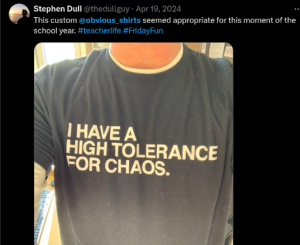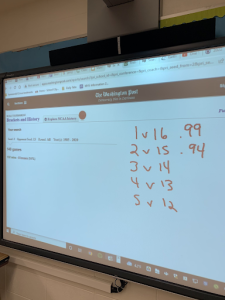
I’ve been told I have a high tolerance for chaos. I’m going to take that as a compliment.
So a tweet that hit my feed one March day resonated:
“The key to enjoying the NCAA Tournament is to root for things in this order:
- the school you attended, if they are in the field and have good vibes
- Chaos”
So Mr. High Tolerance For Chaos, how much ownership for learning are you willing to turn over to your kids? Because the more they own it, the messier it’s gonna be.
Long before I had been introduced to project-based learning in a math classroom, I turned the NCAA Mens’ Basketball Tournament into an activity in my repeat Algebra I class. The thing that made it all work when I first rolled out this activity was an app the Washington Post put together.
In recent years, I’ve moved up the stats and probability unit to coincide with the start of March Madness, so this fits the curriculum. Now it lives in a set of Google Slides the students copy and complete.
I have my students make a tourney bracket strictly by coin flip. My kids who know hoops always laugh when they have two 16 seeds winning in the first round or a double-digit seed winning the whole thing. That, of course, is part of the hook.
Then I point them to the Washington Post’s NCAA Tourney app where they research the first-round win percentage for each of the 16 seeds. (Hint: it’s somewhat linear).

Then, I direct them to a Desmos graph I set up for them to fill in a table with their findings. Then they use sliders to try to make a line of best fit for the data.
Now, it’s time to introduce the difference between theoretical and experimental probability.
I shared with them a video from a math professor at DePaul University on the probability of making a perfect bracket which included some facts about the history of the tournament (at the time the video was made, a 16 seed had never beaten a #1 seed). So, knowing something about the history could help you make a better bracket. What could we do with that?
Make a new bracket with their new-found knowledge, of course. In advance of the activity, I had printed up the blank bracket on both sides of a handout, one labeled “coin flip” and one labeled “for real.”
Among the reflection questions I ask them is to predict how much better they will do compared to their coin-flip bracket. I hold on to all the brackets and track their progress through the tournament, and I offered a little bit of extra credit for the student who made the best bracket.
Even the students (maybe especially the students) who had to ask me what “upset” means in terms of a tournament were able to nail down theoretical vs. experimental probability and use data to make some informed guesses on their brackets.
“This year, the first and second rounds of the tourney take place in the first week of the fourth quarter, the week just before spring break, so this activity takes a couple days where we might typically struggle to get focused on math and turns up the engagement dial.”
This year, the first and second rounds of the tourney take place in the first week of the fourth quarter, the week just before spring break, so this activity takes a couple days where we might typically struggle to get focused on math and turns up the engagement dial. To the point where one year I got an email from a student late on a Thursday night:

Being creative in the classroom, connecting with students, sharing their joys and frustrations on the daily, helping them learn math, it’s what I aim to do. And it always seems to re-energize me for the final quarter.
Resources
Please login or register to claim PGPs.
Alternatively, you may use the PGP Request Form if you prefer to not register an account.



